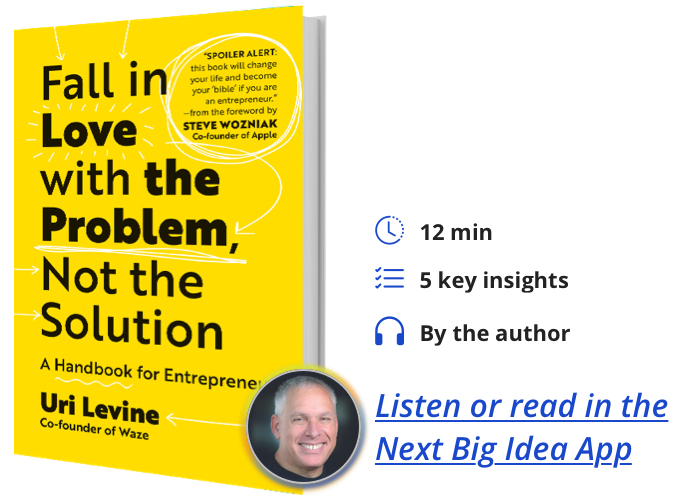Uri Levine is a two-time unicorn builder of Waze and Moovit, which are both traffic and navigation apps.
Below, Uri shares 5 key insights from his new book, Fall in Love with the Problem, Not the Solution: A Handbook for Entrepreneurs. Listen to the audio version—read by Uri himself—in the Next Big Idea App.

1. An entrepreneurship journey is exactly like falling in love.
There are many ideas that you think up, and eventually there is one that you tell yourself, this is the one. This is like going on many dates and eventually meeting someone and telling yourself, she’s the one. At the beginning, you only want to spend time with your date. You don’t care about the rest of the world. Similarly, you only want to spend time with your new idea and your new concept. You think about it from multiple perspectives. You think about it from the problem that you’re going to solve and the people that actually have this problem, and this is how the solution is going to look and this is what will do tomorrow morning and this is my end game and so forth, until you feel confident to tell your friends, this is what I’m going to build.
The first reaction of your friends is always the same: This will never work. These are the nice guys. The lesser nicer guys will tell you, this is the stupidest idea that I ever heard. You take your date for the first time to meet your friends and they’re saying, eh, she’s not for you. This is where you disengage from your friends. The good news is that you are in love and don’t care about anything else. The bad news is that you’re in love and you don’t care about anything else. But in reality, you have to be in love in order to go into this journey because building a startup is a long roller coaster journey that includes failures.
This is critical to understand. All businesses in the world have their ups and downs, but the frequency of those when building a startup are dramatically higher. Perseverance is critical to success.
“If this journey is going to be a journey of failures, then the faster you fail, the more you increase the likelihood of being successful.”
It’s a journey of failures building something new that no has built before. We try something and it doesn’t work so we keep trying different things until we find one thing that does work. If you’re afraid to fail, you already failed because you’re not going to try. Albert Einstein used to say that if you haven’t failed, that’s because you haven’t tried anything new before. Michael Jordan said that failing over and over and over again is what made him successful.
You have to take a leap of faith. You must try in order to innovate. If this journey is going to be a journey of failures, then the faster you fail, the more you increase the likelihood of being successful. This is because you have enough time to make another attempt and another attempt and another attempt. More attempts increase the likelihood of success.
2. Fall in love with the problem.
When thinking about building a startup, I always start with the problem. Think of a problem—a big problem, something worth solving, something that would make the world a better place. Ask yourself, who has this problem? If you happen to be the only person on the planet with this problem, then go to a shrink. It’s much cheaper and easier than building a startup. But if a lot of people have this problem, go and speak with those people to understand their perception of the problem. Know the reality, and only then start building the solution. If you follow this path and your solution works, it’s guaranteed to create value.
But there is a more important part to this. Imagine speaking with people and their feedback is, yeah, go ahead and solve that for me—this is a big problem. All of a sudden you feel committed to this journey. You essentially fall in love with the problem. Falling in love with the problem dramatically increases your likelihood of being successful because the problem becomes the north star of your journey, keeping you focused. Every day you ask yourself whether you’re making progress in solving that problem. When you’re doing that, you succeed faster.
3. Focus on the problem to tell your story effectively.
Imagine it is 2007 and I’m starting Waze, and I came to you and said, I’m building an AI crowdsource based navigation system. You probably don’t care. Now, if I said I’m going to help you avoid traffic jams, then suddenly you do care. That story more easily engages users, customers, investors, media—everyone.
The first part of the journey, and perhaps the most important part, is figuring out product market feed, meaning the value it brings to users. Without this, your idea is dead in the water. No company skipped figuring out product market feed.
“Once a company figures out product market feed they don’t change it.”
Think of all the services that you use every day: searching Google, using WhatsApp, opening Waze, Uber, Netflix. Ask yourself: What is the difference between using any of those things today compared to the first time I used it? There is no difference. We are searching Google today the same way that we searched Google for the first time. We are using Uber today the same way, and we are using Waze today the same way.
Once a company figures out product market feed they don’t change it. Once you do that, you go into the next phases of the journey, which could be figuring out a business model or growth, and so forth.
4. Team building requires hard decisions.
I’ve asked many entrepreneurs why their startup failed, and about half say that the team was not right. I’d ask further, what do you mean the team was not right? Not good enough was one reason, but another reason that I heard quite often was communication issues—which I call ego management issues. But then I would ask them the most important question: When did you know that the team is not correct?
All of them knew within the first month. There was one guy who knew before he even started. The problem was not that the team wasn’t right. The problem was that the CEO did not make hard decisions. Making hard decisions is hard, and this is why making the hard decisions usually goes all the way to the top of an organization. But there is more to it.
“The problem was that the CEO did not make hard decisions.”
Assume that there is someone on a team that shouldn’t be there because they don’t fit. This is a small startup company, maybe 20 or 30 people. Everyone knows when there is a person who doesn’t fit. When the CEO doesn’t do anything, that’s where the problem arises.
5. Firing and hiring is the be-all and end-all.
Firing is a hard decision. Hiring is an easy decision. When hiring new people, mark your calendar 30 days down the road and ask yourself: Knowing what I know today, would I hire this guy again? If the answer is yes 30 days in, then tell that person that you are pleased with their performance so far. If the answer is no, fire that person immediately because from this point on, everyone already knows that this person shouldn’t be there. If you don’t fire that person, this is the beginning of the end of your organization.
I also suggest applying this practice to other aspects of your life. Ask yourself multiple times: Knowing what I know today, would I do something different? If so, then do something different right now. Today is the first day of the rest of your life.
To listen to the audio version read by author Uri Levine, download the Next Big Idea App today:
































